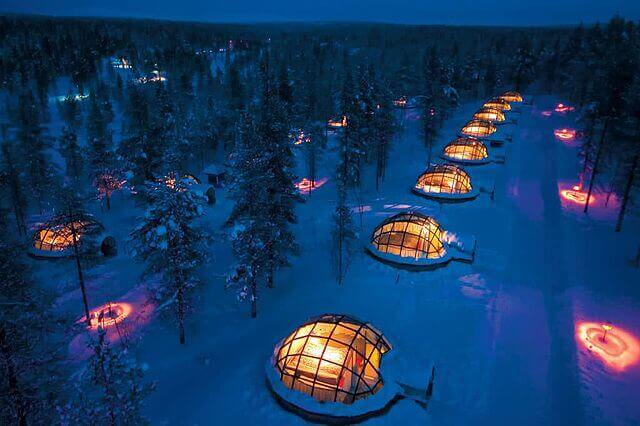Trite as it may sound, COVID has changed everything, forever.
NB: This is an article from IDeaS
The pandemic’s lasting impact is expected to be so altering to life as we know it, the latest batch of newly-born humans has already been deemed Gen-C—the COVID Generation. The typically slow evolution of the way people gather, celebrate, travel, and work was just rocked into an entirely new era we’re all still navigating, and most of the hospitality industry is still reeling.
Subscribe to our weekly newsletter and stay up to date
But certain business segments have clearly benefitted in some ways from the general crisis, chief among them being outdoor accommodations providers. It doesn’t take a data scientist to understand why holiday and RV parks, cabins and campsites would benefit from an infectious disease outbreak necessitating social distancing and isolation, but there’s more to this boom than a global health bust.
The Future of Outdoor Hospitality
Ever heard of “glamping” (glamorous-camping)? It made the cut of new words admitted to the Oxford English Dictionary back in 2016. Or have you noticed more and more outdoorsy lifestyles depicted on your social media feeds? These rising trends had firmly taken root well before the pandemic hit, and now, like the spread of virtual happy hours and digital nomadism, we’ve just jumped forward several years from societal interest to widespread acceptance.
And it’s largely because of the same old song the hospitality industry has grown all too familiar with. The new generation of travelers don’t just want a basic bed, shower, and TV—they want authenticity and memorable experiences. Honeymooners, for instance, seeking romance and comfort have more options today beyond a king suite at a beachside resort and may instead opt for an A-frame in the woods, a vintage Airstream caravan, or even a yurt. Humans have always had an innate desire to travel and connect more with nature, and this trend is here to stay.
But the modern traveler also wants ease and instant accessibility. They want seamless shopping experiences. And if they’re going in for a weekend of hiking and campfires, what many of them really want is the best of both worlds. To be simultaneously off and on the grid, analog and digital, away from the crowds while sharing their experience with the masses on Instagram. Sure, some of us groan and say, “That’s not what camping is all about,” but outdoor accommodations providers with their finger on the pulse are already on the digital transformation train, and it’s not slowing down.
Obvious technological upgrade considerations will involve an overhaul of guest-facing platforms, such as a sleek website upgrade, but to truly be on the right side of the future, outdoor accommodators have been making strategic investments in back-of-house business optimization tools such as an automated revenue management system (RMS).
Revenue Management without Walls
For the uninitiated, revenue management refers to data-driven decisions that optimize inventory availability and price to achieve the highest possible revenue growth. In other words, it’s all about selling the right product, at the right price, through the right sales channel, to the right customer, at the right time.
Revenue (or yield) management dates back to the 1980s when it first showed up in the airline industry—along with shoulder pads and perms—to combat low-cost competition and fill empty seats. With a similar environment of advance-booking consumers, perishable inventories, and a need to balance supply and demand, the hotel industry was quick to adopt a similar concept. Other industries have followed suit over the years discovering an effective means of scaling business models for growth with enhanced profitability and efficiency.
Advanced revenue management solutions feature automated functionality, empowering users to ditch error-prone, time-consuming practices. Spreadsheets and human brainpower just don’t cut it when it comes to the vast amount of data generated and decisions needed daily to maintain optimal revenue performance. By doing certain parts of the job better than a revenue manager can alone, a revenue management system enables its human counterpart to spend more time thinking strategically and finding creative solutions to problems.
And the latest chapter in hospitality revenue optimization looks to be unfolding in the great outdoors. Trailblazing campgrounds, outdoor resorts, campervan parks, and more across North America, Europe, and Australasia have integrated demand-based, dynamic-pricing and inventory-management technology with significant, year-over-year revenue growth.
So, to break it down:
- A cabin or a camping pitch, like a hotel room or airplane seat, is a perishable asset
- If the price is too high, the site isn’t filled, and it doesn’t generate any revenue
- If it’s filled at a discounted rate when the consumer is willing to pay more, the business misses out on additional revenue
- If the cabin or camping pitch isn’t sold that day, it cannot be sold again…
Don’t Leave Money on the (Picnic) Table
For better and worse, the hospitality and travel landscape will never be the same. The competitive outdoor accommodation business of tomorrow will require a revenue management system that fully understands their operations in order to optimize revenue performance and help facilitate a seamless guest experience. With their wide range of accommodation types, mix of long- and short-stay business, membership plans, per-person pricing and unique ownership structures, the outdoor hospitality segment needs a solution with flexible pricing methodologies that meet its unique requirements.
Whether used for a single holiday park or cluster, users can instantly access up-to-date performance data anytime, anywhere. Visually compelling reports and dashboards highlight low-demand periods so marketing teams can stay informed and be engaged to drive business in advance. And during busy and shoulder seasons, automated pricing and inventory controls select the ideal price so businesses can achieve the optimal combination of rate and occupancy.





